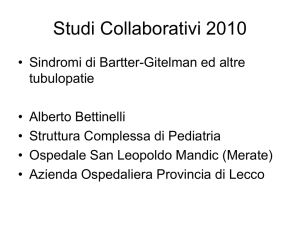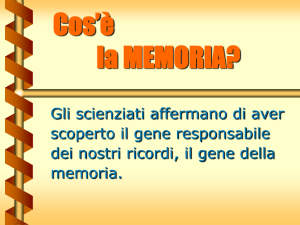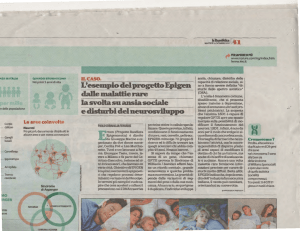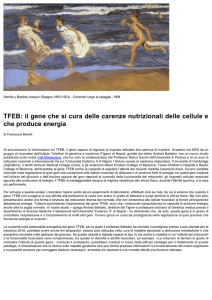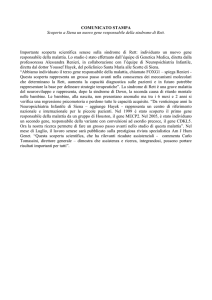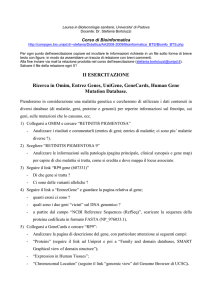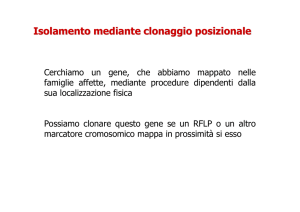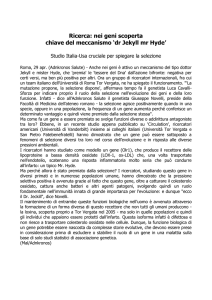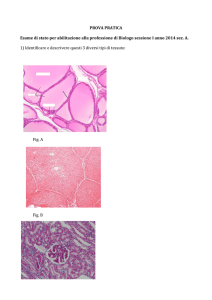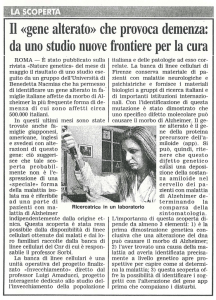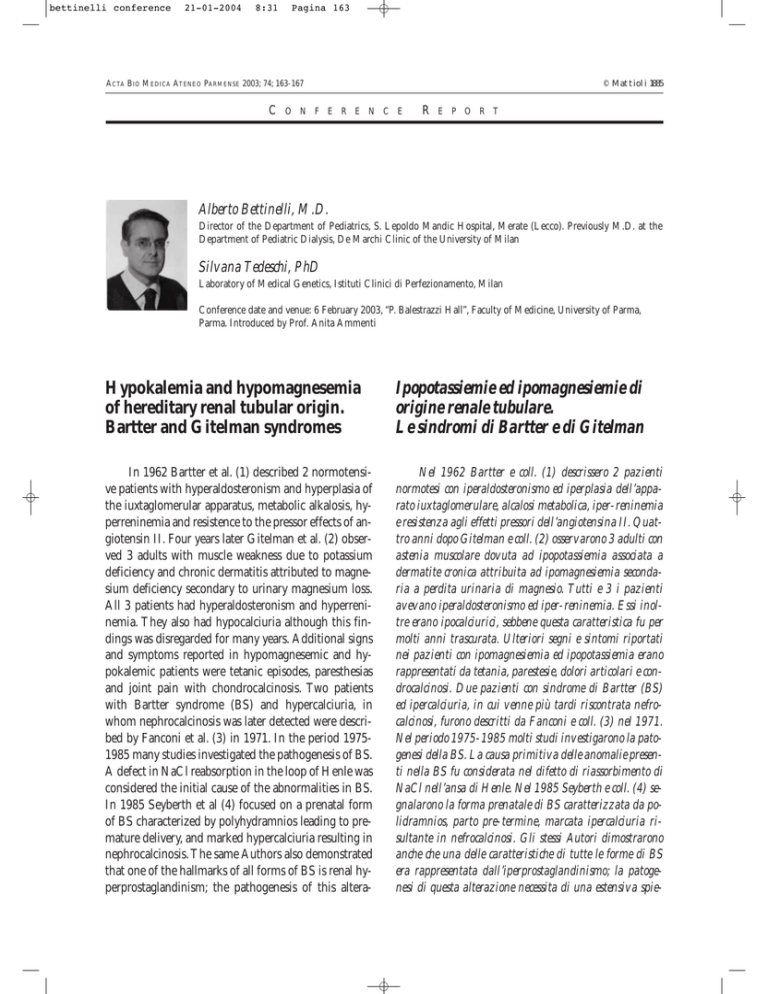
bettinelli conference
21-01-2004
8:31
Pagina 163
ACTA BIO MEDICA ATENEO PARMENSE 2003; 74; 163-167
C
© Mattioli 1885
O N F E R E N C E
R
E P O R T
Alberto Bettinelli, M.D.
Director of the Department of Pediatrics, S. Lepoldo Mandic Hospital, Merate (Lecco). Previously M.D. at the
Department of Pediatric Dialysis, De Marchi Clinic of the University of Milan
Silvana Tedeschi, PhD
Laboratory of Medical Genetics, Istituti Clinici di Perfezionamento, Milan
Conference date and venue: 6 February 2003, “P. Balestrazzi Hall”, Faculty of Medicine, University of Parma,
Parma. Introduced by Prof. Anita Ammenti
Hypokalemia and hypomagnesemia
of hereditary renal tubular origin.
Bartter and Gitelman syndromes
Ipopotassiemie ed ipomagnesiemie di
origine renale tubulare.
Le sindromi di Bartter e di Gitelman
In 1962 Bartter et al. (1) described 2 normotensive patients with hyperaldosteronism and hyperplasia of
the iuxtaglomerular apparatus, metabolic alkalosis, hyperreninemia and resistence to the pressor effects of angiotensin II. Four years later Gitelman et al. (2) observed 3 adults with muscle weakness due to potassium
deficiency and chronic dermatitis attributed to magnesium deficiency secondary to urinary magnesium loss.
All 3 patients had hyperaldosteronism and hyperreninemia. They also had hypocalciuria although this findings was disregarded for many years. Additional signs
and symptoms reported in hypomagnesemic and hypokalemic patients were tetanic episodes, paresthesias
and joint pain with chondrocalcinosis. Two patients
with Bartter syndrome (BS) and hypercalciuria, in
whom nephrocalcinosis was later detected were described by Fanconi et al. (3) in 1971. In the period 19751985 many studies investigated the pathogenesis of BS.
A defect in NaCl reabsorption in the loop of Henle was
considered the initial cause of the abnormalities in BS.
In 1985 Seyberth et al (4) focused on a prenatal form
of BS characterized by polyhydramnios leading to premature delivery, and marked hypercalciuria resulting in
nephrocalcinosis. The same Authors also demonstrated
that one of the hallmarks of all forms of BS is renal hyperprostaglandinism; the pathogenesis of this altera-
Nel 1962 Bartter e coll. (1) descrissero 2 pazienti
normotesi con iperaldosteronismo ed iperplasia dell’apparato iuxtaglomerulare, alcalosi metabolica, iper-reninemia
e resistenza agli effetti pressori dell’angiotensina II. Quattro anni dopo Gitelman e coll. (2) osservarono 3 adulti con
astenia muscolare dovuta ad ipopotassiemia associata a
dermatite cronica attribuita ad ipomagnesiemia secondaria a perdita urinaria di magnesio. Tutti e 3 i pazienti
avevano iperaldosteronismo ed iper-reninemia. Essi inoltre erano ipocalciurici, sebbene questa caratteristica fu per
molti anni trascurata. Ulteriori segni e sintomi riportati
nei pazienti con ipomagnesiemia ed ipopotassiemia erano
rappresentati da tetania, parestesie, dolori articolari e condrocalcinosi. Due pazienti con sindrome di Bartter (BS)
ed ipercalciuria, in cui venne più tardi riscontrata nefrocalcinosi, furono descritti da Fanconi e coll. (3) nel 1971.
Nel periodo 1975-1985 molti studi investigarono la patogenesi della BS. La causa primitiva delle anomalie presenti nella BS fu considerata nel difetto di riassorbimento di
NaCl nell’ansa di Henle. Nel 1985 Seyberth e coll. (4) segnalarono la forma prenatale di BS caratterizzata da polidramnios, parto pre-termine, marcata ipercalciuria risultante in nefrocalcinosi. Gli stessi Autori dimostrarono
anche che una delle caratteristiche di tutte le forme di BS
era rappresentata dall’iperprostaglandinismo; la patogenesi di questa alterazione necessita di una estensiva spie-
bettinelli conference
21-01-2004
8:31
Pagina 164
164
tion needs an extensive explanation. In the period
1985-1990 it became even clearer that the so-called BS
was in fact a heterogeneous group characterized by primary renal tubular disorders associated with hypokalemic metabolic alkalosis and hyperreninemia with normotension. In some cases prenatal-neonatal diagnosis
was possible in the presence of important signs and
symptoms such as polyhydramnios, polyuria and dehydration. In other patients diagnosis was made during
childhood due to the appearance of tetanic crises or
growth failure. Other subjects were completely asymptomatic and the diagnosis was made in adolescent or
adult life following blood tests prescribed for intercurrent diseases. In 1987 Rodriguez Soriano et al. (5) observed that in the patients reported by Gitelman et al
more than 20 years earlier (2), in addition to hypokalemia and hypomagnesemia of renal tubular origin, the
striking finding was a decrease of urinary calcium excretion. The authors speculated that the dissociation of
renal calcium from magnesium transport, the moderate degree of sodium, chloride and potassium wasting,
the exaggerated natriuresis and kaliuresis after furosemide, all pointed to a hereditary defect in the distal tubule, which closely resembles the effect of chronic administration of a thiazide diuretic. This finding, i.e. hypocalciuria, offers a differential criterion from BS. The
latter might caused by an intrinsic impairment of NaCl reabsorption in the ascending limb of the loop of
Henle, which mimics the effects of Henle loop diuretics (furosemide, bumetanide). We evaluated the diagnostic values of calcium excretion levels in 34 pediatric patients with primary renal tubular hypokalemic
metabolic alkalosis, divided into 2 groups: BS was hypothesized in 18 patients with normal-high molar urinary calcium/creatinine ratio and Gitelman syndrome
in 16 with a low ratio and hypomagnesemia (6). Some
clinically important differences were observed. Patients
with a diagnosis of BS were often born after pregnancies complicated by polyhydramnios, were delivered
prematurely, and had growth failure, polyuria and polydipsia. Patients with GS had tetanic episodes at school
age. We concluded that BS and GS are 2 distint variants of primary renal tubular hypokalemic alkalosis
and are distinguished on the basis of urinary calcium
levels. A new recent definition of reference values for
hypocalciuria was published: values of molar urinary
A. Bertinelli, S. Tedeschi
gazione. Nel periodo 1985-1990 divenne sempre più
chiaro che la cosiddetta BS risultava in un gruppo eterogeneo di malattie tubulari renali con alcalosi metabolica ipopotassiemica, iper-reninemia e normotensione. In alcuni
casi una diagnosi prenatale-neonatale era possibile in presenza di importanti segni e sintomi quali polidramnios,
poliuria e disidratazione. In altri pazienti la diagnosi veniva effettuata nell’infanzia per la comparsa di crisi tetaniche o ritardo di crescita. Altri soggetti erano completamente asintomatici e la diagnosi veniva formulata nell’adolescenza o nell’età adulta in seguito ad esami ematologici prescritti per malattie intercorrenti. Nel 1987 Rodriguez Soriano e coll. (5) osservarono che nei pazienti riportati da Gitelman più di 20 anni prima (2) in aggiunta all’ipopotassiemia ed ipomagnesiemia di origine renale tubulare, la caratteristica principale era rappresentata dall’ipocalciuria. Gli autori specularono che la dissociazione del
trasporto del calcio da quello del magnesio, la moderata
perdita di sodio, cloro e potassio, e l’esagerata natriuresi e
kaliuresi dopo furosemide erano in accordo con un difetto
ereditario nel tubulo distale, che assomigliava all’effetto
secondario alla somministrazione cronica di diuretici tiazidici. L’ipocalciuria offre un criterio differenziale dalla
BS. Quest’ultima poteva essere causata da un difetto intrinseco nel riassorbimento di NaCl nel tratto ascendente
dell’ansa di Henle che assomiglia all’effetto di diuretici
dell’ansa (furosemide, bumetanide). Abbiamo valutato il
valore diagnostico dell’escrezione del calcio in 34 pazienti
pediatrici con ipopotassiemia primitiva renale-tubulare ed
alcalosi metabolica, divisi in 2 gruppi: la BS veniva ipotizzata in 18 pazienti con valori normali elevati del rapporto molare urinario calcio/creatinina mentre una GS
veniva ipotizzata in 16 pazienti con ipocalciuria ed ipomagnesiemia (6). Venivano rilevate importanti differenze
cliniche nei 2 gruppi. I pazienti con una diagnosi di BS
erano spesso nati prematuramente, dopo gravidanze complicate con polidramnios e presentavano ritardato accrescimento, poliuria e polidipsia. I pazienti con GS avevano
presentato crisi tetaniche in età scolare. Le conclusioni erano che le sindromi di BS e GS rappresentavano 2 diverse
varianti di alcalosi ipopotassiemica renale tubulare e che
erano distinguibili sulla base dell’escrezione urinaria di
calcio. Una nuova recente definizione dei valori di riferimento per l’ipocalciuria è stata recentemente pubblicata:
valori di rapporto molare urinario calcio/creatinina <0.27
(cioè 0.010 in mg/mg) per lattanti e inferiori a 0.12 (cioè
bettinelli conference
21-01-2004
8:31
Pagina 165
Conference Report
calcium/creatinine <0.27 (i.e. 0.010 in mg/mg) for infants and <0.12 (i.e. 0.044 mg/mg) for children >5
years were suggested to define the hypocalciuria (7).
The molecular approach originated from the observation of similar biochemical features in patients
with GS and BS and subjects receiving thiazide and
Henle loop diuretics respectively.
Initially, it was possible to identify the protein altered in GS and the gene SLC12A3 coding for this
cotransporter (8, 9). Successively, all the genes encoding proteins found altered in BS type I, II and III
were cloned (10-13). All the four genes exhibit autosomal recessive inheritance trait.
The identification of mutations in the SLC12A3
gene clarified the molecular basis of GS. Defects in
the thiazide-sensitive Na+/Cl- cotransporter (NCCT)
are caused by mutations, leading to impaired reabsorption of sodium chloride in the distal convoluted
tubule and responsible for the Gitelman phenotype.
The exon-intron organization of the SLC12A3 gene
has been determined and revealed that the human
NCCT is encoded by 26 exons. Sequence analysis predicted a protein composed by 1021 aminoacids, distributed in 12 putative transmembrane domains with intracellular amino- and carboxytermini. Various loss of
function mutations have been detected in affected individuals but not in normal controls. The mutations
include single base substitutions affecting either residues highly conserved among the species or splice sites that probably cause exon skipping. Nonsense mutations (premature stop codon) as well as deletions/insertions leading to a frameshift were identified. Frameshift, nonsense and splice site mutations lead to
truncated proteins whereas the effect of missense mutations remains to be investigated in functional tests.
In contrast to GS, BS exhibits a vast genetic heterogeneity because the two antenatal forms (Bartter
type I and II) and the classic Bartter Syndrome (type
III) are caused by mutations affecting three different
genes: SLC12A1, KCNJ1 and CLCNKB expressed in
the thick ascending limb of Henle. They respectively
encode the Na+/K+/2Cl- co-transporter (NKCC2),
the renal potassium channel (ROMK) and the renal
chloride channel (ClC-Kb). All these transmembrane
proteins have similar structure, with transmembrane
domains and intracellular amino- and carboxytermini.
165
0.044 mg/mg ) per bambini sopra ai 5 anni sono stati proposti per definire l’ipocalciuria (7).
L’approccio molecolare è originato dall’osservazione
di alterazioni biochimiche simili in pazienti con GS e BS
e soggetti che ricevevano terapia rispettivamente con diuretici tiazidici e dell’ansa.
Inizialmente, è stato possibile identificare la proteina
alterata nella GS ed il gene SLC12A3 che codifica per questo cotrasportatore (8, 9). Successivamente, sono stati clonati tutti i geni codificanti le proteine trovate alterate nella BS tipo I, II e III (10-13). Per i quattro geni sono state osservate modalità di trasmissione autosomica recessiva.
L’identificazione di mutazioni del gene SLC12A3 hanno
permesso di chiarire le basi molecolari della GS. Difetti del
cotrasportatore Na+/Cl- tiazide-sensibile (NCCT) sono
causati da mutazioni che alterano il riassorbimento di sodio cloruro nel tubulo convoluto distale e sono responsabili
del fenotipo Gitelman. È stata definita l’organizzazione
introne-esone del gene SLC12A3 da cui è emerso che
l’NCCT umano è codificato da 26 esoni. L’analisi di sequenza prevede una proteina composta da 1021 aminoacidi distribuiti in 12 domini putativi transmembrana con
estremità amino e carbossiterminale intracellulari. Varie
mutazioni con perdita di funzione della proteina sono state identificate in individui affetti ma mai in controlli normali. Le mutazioni sono sostituzioni di singole basi a carico di residui altamente conservati attraverso le speci o a
carico di siti di splicing che portano probabilmente ad un
salto di esone. Sono state identificate anche mutazioni
nonsense che creano un codone di stop prematuro così come
delezioni/inserzioni che causano un frameshift (slittamento di lettura). Mutazioni frameshift, nonsense e su siti di
splicing portano a proteine tronche mentre l’effetto delle
mutazioni missense deve essere ancora analizzato con test
funzionali.
A differenza della GS, la BS mostra un’ampia eterogeneità genetica poiché le due forme antenatali (tipo I e
II) e la forma classica della sindrome di Bartter (tipo III)
sono causate da mutazioni che colpiscono tre diversi geni:
l’SLC12A1, il KCNJ1ed il CLCNKB espressi nel tratto
spesso ascendente dell’ansa di Henle. Codificano rispettivamente per il cotrasportatore Na+/K+/2Cl- (NKCC2),
i canali renali del potassio (ROMK) e del cloro (ClCKb). Tutte queste proteine transmembrana presentano
una struttura simile, con domini transmembrana ed
estremità amino e carbossiterminali intracellulari. L’ana-
bettinelli conference
21-01-2004
8:31
Pagina 166
166
Molecular analysis demonstrated characteristic
mutational patterns for each gene. In GS and BS type
I the majority of variants are represented by missense
mutations (aminoacid substitutions) with no preferential mutation hot spot along the transmembrane protein. A particularity was demonstrated in the ROMK
channel (Bartter type II) that is encoded by five exons
producing five distinct transcripts. Almost all mutations reported so far in the KCNJ1 gene are located in
exon 5 and alter all predicted isoforms of the channel.
The CLCNKB gene presents a high degree of homology (94%) with CLCNKA, a gene located 11kb apart
from CLCNKB, coding for another channel member
of the vast ClC family. The closeness causes unequal
crossing-over that results in frequent homozygous deletions of the entire gene with significantly impaired
transport of chloride across the basolateral membrane
through the chloride channel ClC-Kb.
Treatment. If great recent advances are obtained in
the molecular genetics knowledges of these diseases, the
treatment has remained quite the same of about 20 years
ago. In neonates and infants with BS large amounts of
fluids and electrolytes are given by intravenous or oral
routes. The amount required in a stable condition may
be extimated approximately 3 mmol/kg body weight of
both sodium and potassium chloride. If the growth is
insufficient and/or hypokalemia relevant (especially <3
mmol/l) Indomethacin is the first drug of choice; the
dose remain to be tested for each patient (from 0.5 to 5
mg/kg/day in 3 doses); such a drug is contraindicated by
many Authors under 6 months of age. The appearance
of gastroenteric side effects contraindicates Indomethacin in many patients. Other antiprostaglanding drugs
may be used (recently rofecoxib has been also proposed)
Other than KCl and magnesium supplementations, the
main drugs utilized in GS (where hyperprostaglandinism is not present) are: spironolactone (50-200 mg/day)
or amiloride (10-30 mg/day). The use of these antialdosteronic drugs is able to obtain an increase of serum potassium of about 0.5 mmol/L.
Prognosis. Up to now only one long-term study
on GS is available on a large group of patients which
demonstrates a reduced health quality of life for GS
patients compared to a control group (14). In BS, the
main possible complication is represented by renal failure, referred in a few patients.
A. Bertinelli, S. Tedeschi
lisi molecolare ha dimostrato pattern mutazionali caratteristici per ogni gene. Nella GS e nella BS tipo I, la maggior parte delle varianti è rappresentata da mutazioni
missense (sostituzioni di aminoacidi) senza hot spot preferenziale di mutazione lungo la proteina transmembrana. Una peculiarità è stata dimostrata nel canale ROMK
(Bartter tipo II), il quale è codificato da 5 esoni che producono 5 trascritti diversi. Quasi tutte le mutazioni riportate finora nel gene KCNJ1 sono localizzate nell’esone
5 ed alterano tutte le isoforme predette del canale. Il gene
CLCNKB presenta un alto grado di omologia (94%) con
il CLCNKA, un gene localizzato a 11kb dal CLCNKB,
che codifica per un altro canale, membro della grande famiglia dei ClC. La vicinanza causa crossing over ineguali che portano a frequenti delezioni in omozigosi dell’intero gene con significativo danno al trasporto di cloro attraverso la membrana basolaterale tramite il canale del
cloro ClC-Kb.
Terapia. Se grandi avanzamenti sono stati ottenuti
nelle conoscenze di genetica molecolare di queste malattie,
la terapia è rimasta essenzialmente la stessa di circa 20
anni fa. Neonati e lattanti affetti da BS necessitano di
grandi quantità di liquidi ed elettroliti e.v. o per os. In
condizioni di stabilità la quantità di elettroliti richiesta
può essere stimata approssimativamente di 3 mmol/kg di
Na e KCl. Se la crescita risulta insufficiente e/o l’ipokaliemia è rilevante (specie se <3 mmol/l), l’Indometacina rimane il farmaco di prima scelta; le dosi vanno testate per
ciascun paziente (variabili da 0.5 a 5 mg/kg/die); tale
farmaco viene controindicato da molti Autori al di sotto
dei 6 mesi. La comparsa di effetti collaterali a livello dell’apparato gastroenterico ne controindicano l’uso in molti
pazienti. Altri farmaci antiprostaglandinici possono essere usati (recentemente è stato proposto anche il rofecoxib).
Nella GS (dove l’iperprostaglandinismo non è in genere
presente), oltre a supplementazioni di NaCl e magnesio, i
farmaci maggiormente utilizzati sono lo spironolattone
(50-200 mg/die) o l’amiloride (10-30 mg/die). L’uso di
questi farmaci antialdosteronici è in grado di ottenere un
aumento dei valori serici di potassio di circa 0.5 mmol/l.
Prognosi. Fino al momento attuale solo uno studio su
un largo gruppo di pazienti con GS è disponibile; viene
dimostrata una ridotta qualità di vita rispetto ad un
gruppo di controlli (14). In pazienti con BS la maggiore
possibile complicanza, riferita in alcuni pazienti è rappresentata dall’insufficienza renale.
bettinelli conference
21-01-2004
8:31
Pagina 167
Conference Report
References
1. Bartter FC, Pronome P, Gill JR, MacCardle RC. Hyperplasia of the juxtaglomerular complex with hyperaldosteronism
and hypokalemic alkalosis: a new sindrome. Am J Med 1962;
33: 811-28.
2. Gitelman HJ, Graham JB, Welt LG. A new familial disorder characterized by hypokalemia and hypomagnesemia.
Trans Assoc Am Physicians 1966; 79: 221-35.
3. Fanconi A, Schachenmann G, Nussli R, Prader A. Chronic
hypokalemia with growth retardation, normotensive hyperrenin-hyperaldosteronism (“Bartter’s syndrome”), and hypercalciuria: report of two cases with emphasis on natural
history and on catch-up growth during treatment. Helv
Paed Acta 1971; 26: 144-63.
4. Seyberth HW, Rascher W, Schweer H, et al. Congenital
hypokaemia with hypercalciuria in preterm infants: a hyperprostaglandinuric tubular syndrome different from Bartter
syndrome. J Pediatr 1985; 107: 694-701.
5. Rodriguez-Soriano JA, Vallo A, Garcia-Fuentes M. Hypomagnesemia of hereditary origin. Pediatr Nephrol 1987; 1:
465-72.
6. Bettinelli A, Bianchetti MG, Girardin E, et al. Use of calcium excretion values to distinguish two forms of primari
renal tubular hypokalemic alkalosis: Bartter and Gitelman
syndromes 1992; 120: 38-43.
7. Bianchetti MG, Edefonti A, Bettinelli A. The biochemical
167
diagnosis of Gitelman disease and the definition of “hypocalciuria”. Pediatr Nephrol 2003; 18: 409-11.
8. Simon DB, Nelson-Williams C, Bia MJ, et al. Gitelman’s
variant of Bartter syndrome, inherited hypokalemic alkalosis, is caused by mutations in the thiazide-sensitive Na-Cl
cotransporter. Nat Genet 1996; 12: 24-30.
9. Mastroianni N, De Fusco M, Zollo M, et al. Molecular
cloning, expression pattern and chromosomal localization
of the human Na-Cl thiazide-sensitive cotransporter
(SLC12A3). Genomics 1996; 35: 486-93.
10. Simon DB, Karet FE, Hamdan JM, Di Pietro A, Sanjad
SA, Lifton RP. Bartter’s syndrome, hypokalemic alkalosis
with hypercalciuria, is caused by mutations in the Na-K2Cl cotransporter NKCC2. Nat Genet 1996; 13: 183-8.
11. Simon DB, Karet FE, Rodriguez-Soriano J, et al. Genetic
heterogeneity of Bartter’s syndrome revealed by mutations
in the K+ channel, ROMK. Nat Genet 1996; 13: 183-8.
12. Simon DB, Bindra RS, Mansfield TA, et al. Mutations in
the chloride channel gene, CLCNKB, cause Bartter’s syndrome type III. Nat Genet 1997; 17: 171-8.
13. Shuck ME, Bock JH, Benjamin CW, et al. Cloning and
characterization of multiple forms of the human kidney
ROM-K potassium channel. J Biol Chem 1994; 269, 39:
24261-70.
14. Cruz DN, Shaer AJ, Bia MJ, et al. Gitelman’s syndrome
revisited: an evaluation of symptoms and health-related
quality of life. Kidney Int 2001; 59: 710-7.

